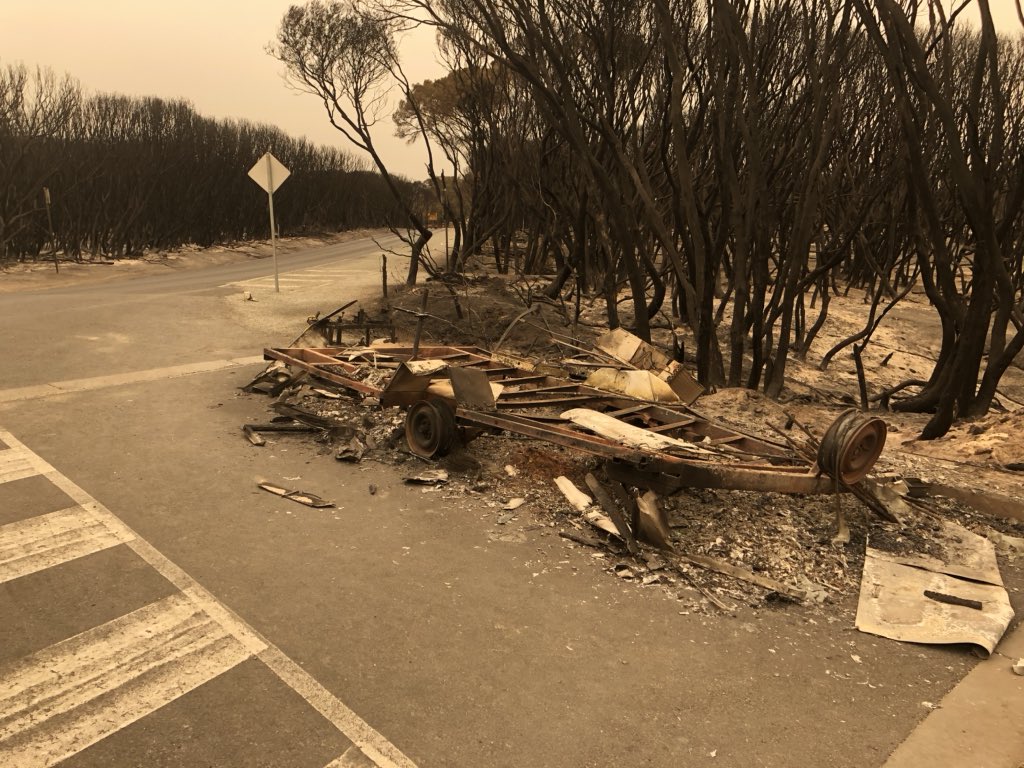How will the bushfire crisis affect your fundraising this year?
The devastation of the bushfires has led to an outpouring of generosity from across the globe. But even though the emergency is far from over, many not-for-profits will need to start thinking carefully now about how they respond both in the short and medium term to these extreme circumstances.
 Mallacoota skyline: Photo credit @brendanh_au
Mallacoota skyline: Photo credit @brendanh_au
Overcoming gaps in crisis response
Some organisations will face challenges running an effective relief effort and coping with the magnitude of not only the disaster but the surge of public attention.
Recently, Foodbank was inundated with donations of food by Melbournians wanting to support the charity and get much needed items to communities more severely affected. However, after dealing with a kilometre-long queue of cars waiting to donate goods, the organisation had to turn vehicles away and stop any further donations, requesting that people consider giving a monetary donation instead.
This scenario identifies the desire of the public to give but also highlights the operational issues that arise when the type of donation doesn’t match the needs of the organisation or the ability of the organisation to deal with the influx of material aid.
Therefore, plans should be put in place to overcome any gaps identified within your organisation over the last few weeks so you can better position your organisation and best service your community when disasters arise in the future.
Some common issues that not-for-profits may face when there is a spike in attention or gifting include:
- Lack of crisis management plan leads to uncoordinated responses and threats to organisational resilience
- An inability of your web site to deal with increased traffic
- Out-of-date web site and/or social media
- Problems with the giving platform used
- Volunteer management
- Not being able to get the goods / money to those that need it quickly enough
- Slowness in thanking donors, especially major donors, causing stewardship issues
- Keeping board members up to date with the on-the-ground situation
- Less than ideal PR due to not having a designated media representative
Use our checklist below to future-proof your organisation and avoid these pitfalls in this or future crises.
Turning new donors into lifelong supporters
It will also be important to properly resource your donor stewardship program so that you keep as many donors as possible over the succeeding years. Donor attrition has been a real problem for many not-for-profits after previous tragedies, so we recommend that you start enacting your donor stewardship plans now to minimize this issue.
The first step should always include thanking new donors and educating them about the important work that you do within the community. People who make large gifts should not be treated the same as those who gave small gifts especially when it comes to how quickly they are thanked, and by which means (e.g. automated receipt vs personal email/phone call from CEO/ Chair when appropriate).
The second step should then be to engage with the donor to build up the relationship and help them better understand the importance of ongoing giving, as a means to make a greater impact. When it comes to micro-donations, you should focus on providing the giver with narratives and insight into how their funds can make a long-term difference in the lives of those they wish to support. This can be a powerful way to convert a once-off giver into a loyal, committed micro-philanthropist.
When it comes to major gifts, the relationship building phase is even more important. Personal thank you notes, invitations to meet, public acknowledgments of funds (when endorsed) should all be considered as a way to build up relationships with key donors. The aim should be to give thanks but also to discuss an ongoing partnership.
Repivot or refocus?
Your organisation may also need to think about whether it could or should pivot services or messaging to best meet the needs of the community.
For example, St Kilda Mums (who collect, sort and redistribute essential nursery equipment, clothing, books and toys for babies and school age children) has used social media and their web site to let people know how they can help families affected by the bushfires. This includes immediate cash donations to other charities on the front line and essential items via St Kilda Mums’ normal service in the coming weeks. They have been careful to put the needs of the families affected ahead of their organisational needs, so they have not been seen as trying to take advantage of the situation but rather being an important contributor in this time.
However, organisations can only refocus their efforts or messaging if their cause has a good alignment with the crisis.
For some charities, this alignment is obvious (think climate change, animal protection, welfare and material aid) but there will be some organisations who may be perceived to be on the periphery of the emergency but could make a real difference to people, wildlife or habitat affected by the fires. These organisations need to make sure that their supporters are aware of what will be done with their donations to address the aftereffects of the fires and the use of case studies and individual stories can really help illustrate the impact that can be achieved.
Organisations with no alignment with the crisis need to avoid trying to make a connection as people may find this insincere and lower their estimation of the organisation. There always should be a connection between your activities and messages with your mission and theory of change.
However, you may be able to show your support (and thus raise your organisation’s profile and impact) by publicly aligning with and supporting key not-for-profits within your community that are doing good and benefiting the same community that you work with. Collaboration between not-for-profits is often beneficial and, in a time of crisis, shows commitment and loyalty to the community in which you serve, even if your organisation will not directly benefit.
Managing donor fatigue
Will donors who give to bushfire relief donate again later in the year to the same charity or other charities?
There is no simple answer to this, but it’s an issue that we will all need to consider.
To overcome possible donor fatigue, you will need to think about your appeal message and timing, and this will depend on your cause.
Asking people who have donated to the bushfire emergency too soon after the crisis and you may be seen as insensitive or uncaring. Leaving it too long or not crafting an appropriate message could also mean you miss out.
The language you use will need to be incredibly sensitive to the unfolding situation which will substantially change over time as the crisis response turns to repair, restoration and rebuilding of lives, property and habitat.
For charities who have received money in response to the bushfires, when reaching out to first time donors, we recommend that you focus your message on how their donation assisted in the relief effort. In subsequent communications, it would be wise to focus on long-term impact and how ongoing donations would assist with longer term projects.
 Photo credit @brendanh_au
Photo credit @brendanh_au
For charities not providing relief to people or wildlife impacted by bushfires, you will need to be very clear as to the impact your not-for-profit will have, especially in 2020, or else you run the risk of potential donors using the fact that they have given to the bushfire crisis as an excuse not to give to your cause.
You will also need to make sure that you are carefully stewarding your key donors and working hard to maintain or increase their engagement with your organisation and the impact you are having. Focussing on key (significant) projects – backed by a budget, business plan and case for support – will greatly help with attracting sizeable donations.
Our recommendations for positioning your charity after the bushfires have been controlled
As a non-profit organization, your heart undoubtedly goes out to the people, wildlife and habitat impacted by the bushfires. You want to help as much as you can, but you also recognize the sensitive situation we are currently in. You may have your own cause and mission to focus on. You also don’t want to be insensitive when asking for donations during a nationally public time of distress.
Therefore, we recommend that you:
- Evaluate the situation in terms of the closeness of your cause and those impacted by the emergency
- Consider whether you refocus your activities or messages to better align with community needs
- Consider if partnerships might benefit the community and your organisation
- Consider if you need to revisit your strategic plan or change your goals for this year in light of the disaster
- Weigh your options as to when and how to fundraise
- Organisations located in bushfire affected regions will need to look beyond their area for donations and consider if increased international attention can be tapped into
- Charities not supporting the bushfire recovery will need to remind people of the importance of the cause and exactly how their donation will shift the dial. They will need to show sensitivity to the bushfire crisis but explain why their cause matters as well
- Steward your new and existing donors as never before
- Engage your new donors to develop the relationships required for major, regular and planned giving
- Strengthen your relationships with existing donors to prevent donor fatigue affecting your revenue stream
Times of crisis are challenging for all not-for-profits but with empathy, collaborative strategic thinking and careful consideration, the most appropriate strategic fundraising plan for your organisation in 2020 can become clear.
Future-proofing your organisation for times of crisis – checklist
| Ensure your organisation has a crisis management plan that deals with issues such as response guidelines, roles and duties for responsible persons (to coordinate messaging, liaise with media etc), communication with Board members, senior staff, community members and donors. | |
| Liaise with your website provider / host to discuss impact of increased traffic, back-up solutions etc. | |
| Review your social media plan – do you adequately communicate with your community members? Which platforms should be used to reach your community? How will you be best placed to get urgent messages out to your community? | |
| Review your giving platform – does it have wide reach? Is it user-friendly? Are you able to distribute funds quickly in a crisis? | |
| Consider your volunteer program – is it being managed well so that volunteers can be called into action in a crisis? How do you communicate with your volunteers? Do you have a volunteer agreement in place? How do you train volunteers quickly in a time of crisis? Do you need to run a recruitment drive for volunteers so that you have people on stand-by? Does this program need funding? | |
| Donor stewardship – have you got this program set up in a way that enables you to track donations and thank donors? Are you prepared to resource the program so that it can build the depth of relationships required to minimise donor attrition, convert once-off donors into loyal givers and attract major investments? | |
| External communication management – during a crisis, is your organisation well positioned to communicate to the community, donors and media? Do you need to consider an external representative or provide up-skilling for your CEO / Chair? | |
| Theory of change – review your theory of change following a crisis to consider if it still best meets the vision, mission and aims of the organisation and serves those in need |